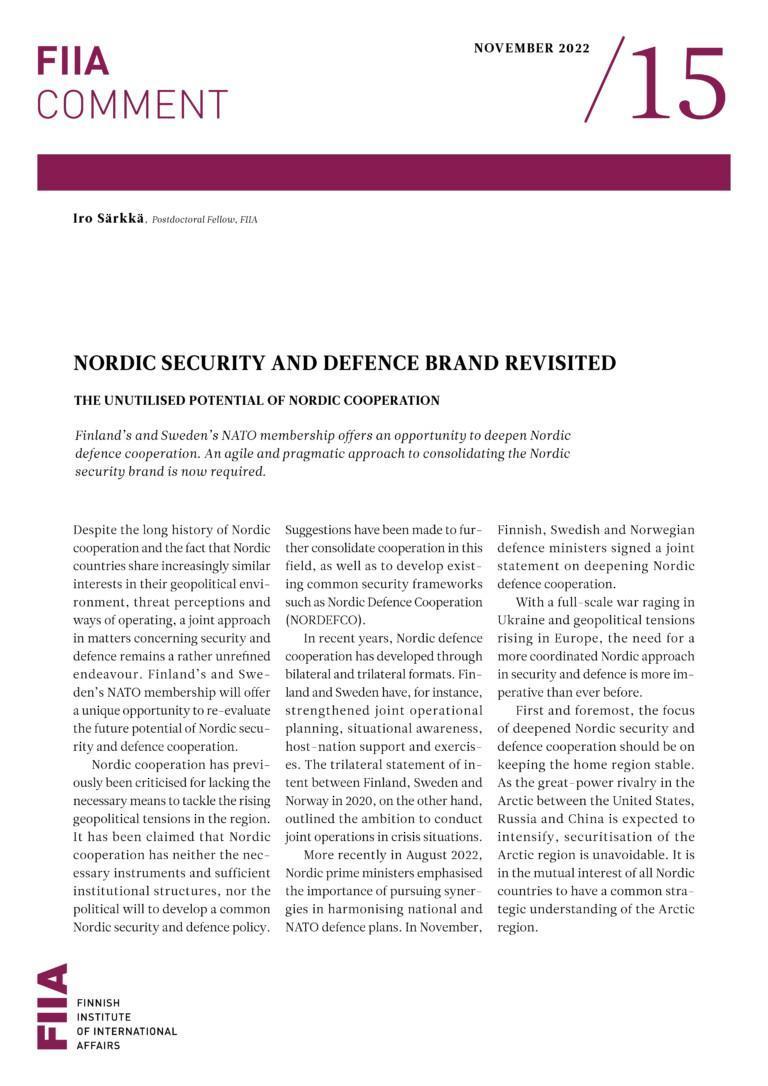NATO allied nations will meet at the Vilnius Summit in Lithuania on 11–12 July 2023. They must try to resolve several difficult questions related to NATO’s collective defence, deterrence and security, and the limits of its enlargement. The Alliance’s ability to do so will determine its credibility to act in times of crisis.
Since the onset of Russia’s unprovoked, brutal war in Ukraine, collective defence and deterrence have come to matter more than ever before in NATO’s task portfolio. NATO extended its defence posture and forward presence on the Eastern Flank by establishing four new battlegroups in Romania, Bulgaria, Hungary, and Slovakia, and reinforced its presence in the Baltic countries by extending its peacetime air-policing operations and air defence exercises.
Over the past year, the Alliance has focused on developing a new strategic concept for the Deterrence and Defence of the Euro-Atlantic Area (DDA), the largest adaptation of the Alliance’s military posture in the post-Cold War period. The objective of DDA is to operationalize collective defence within the North Atlantic region after two decades of so-called out-of-area operations and crisis management taking place outside the region.
In Vilnius, NATO is expected to communicate how DDA will be put into action. As an integral part of this new defence strategy, NATO is now developing regional, functional and interlinked plans in the air, land, sea, cyber and space domains to better deter and defend against all threats. To fully operationalize these plans and to integrate them with the NATO Defence Planning Process (NDPP), the Alliance is adopting a more readily deployable force model as well as a command-and-control structure with higher readiness and national interoperability requirements.
With these changes, NATO is now faced with several difficult questions, so-called security conundrums, which it needs to resolve.
The biggest question mark over NATO’s transformation is the political will to execute these plans. At the Vilnius Summit, NATO will reassess its 2014 defence pledge, which stated that 2% of national GDP should be spent on defence, with a 20% share for materiel procurement and research and development (R&D). This 2% goal will hardly be achieved by the Summit as currently only about a fourth of NATO members meet this target. However, member states do seem to be moving in the right direction. Therefore, the real question is not so much what the new pledge states exactly, or how the Alliance will monitor it in the future, but whether the allied nations are willing to commit to it in the long term.
The second question has to do with threat perceptions arising from geographical differences. Although there is no desire to form permanent blocs in the Alliance, in reality, there are groups of nations within NATO which share divergent threat perceptions both in the Euro-Atlantic area and globally. The Baltic countries on NATO’s north-eastern flank would be particularly vulnerable in the unlikely but possible event of Russian aggression, due to their small land area and close geographical proximity to Russia. For the southern Mediterranean and Western European NATO members, terrorism figures more strongly in their national threat assessments.
In Vilnius, NATO is likely to announce that it will strengthen the dialogue with its Indo-Pacific partners – Australia, Japan, New Zealand, and the Republic of Korea – for whom China poses a major security concern. Although NATO does not conceive of China as a threat but rather as a security challenge, there is a growing sense of urgency to keep a close eye on China’s development.
Therefore, NATO will have to come to terms with a certain degree of regionalization of collective security. This unavoidable development is likely to bolster a stronger status for regional bi-, tri- and minilateral formats of defence cooperation, such as NORDEFCO, Nordic-Baltic cooperation and the UK-led Joint Expeditionary Force. It will also serve more active efforts by NATO to develop global cooperative security.
The third conundrum relates to the limits and the credibility of NATO’s enlargement rhetoric. Finland’s and Sweden’s accession processes have demonstrated that although the Alliance is open to welcoming new members with similar values and security interests into the Euro-Atlantic family, national reservations may complicate the process. Hungary and Turkey have unnecessarily prolonged Finland’s and Sweden’s accession processes for their own national benefits. In the future, NATO countries must put greater pressure on recalcitrant member states who act this way.
When it comes to enlargement, the most difficult question, however, relates to Ukraine. Although the allied nations have provided unprecedented economic and military support for Ukraine, they have differing views on how and when Ukraine should be invited to join the Alliance. If NATO lowered the threshold of accession requirements for Ukraine, it would set a precedent for other potential membership hopefuls in precarious situations, such as Georgia and Moldova, which are also struggling with increased Russian menace.
Instead of changing the criteria, NATO needs to show credible and sustainable solidarity for Ukraine. At the Vilnius Summit, the Alliance should commit to a more robust package of political and practical support for Ukraine and agree on a roadmap for the country’s interoperability, leading to eventual NATO membership as a long-term objective. A concrete step on this path is to transform the NATO-Ukraine Commission into the NATO-Ukraine Council, a joint consultative forum between NATO and Ukraine, to monitor this process.
Ultimately, NATO’s credibility lies not in its rhetoric but in its actions. The Alliance must be able to address these difficult questions effectively to maintain its credibility in times of crisis.









